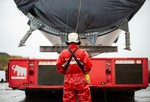11/12/2005
Imagine energy without fuel - wind energy, a free fuel that tackles oil price rises
The EWEA, the European Wind Energy Association, published an opinion piece (1) and advert (2) promoting the benefits of wind energy to directly tackle oil price rises. The full page advert “Imagine energy without fuel” - published by the industry group in Brussels main newspaper - illustrates that wind power is one of Europe’s largest indigenous energy resources and it is still largely unexploited. Wind energy is a significant resource; it is safe, clean, and abundant. Unlike conventional fuels, wind energy is an indigenous supply permanently available in virtually every nation in the world, delivering energy security benefits of eliminating fuel costs and long term fuel price risk, and avoiding the economic, political and supply risks of dependence on imports from other countries.
Wind power has no resource constraints; the fuel is free and endless. “As oil prices continue to spiral upwards, the era of cheap fossil fuels is coming to an end. The era of free fuel - which is what wind energy delivers - is coming into its own”, said EWEA CEO Corin Millais. “With the world talking about how expensive fuel is, the merits of a technology providing a free fuel supply are indisputable. In the context of rising oil prices, a reappraisal of the economic value of wind energy is overdue”.
The price of oil has more than tripled since 2001 and in the summer 2005 reached an all-time high of almost $70. The last 3 global recessions were caused by global price rises. Before the oil prices rises, the European Commission’s Green Paper on the Security of Energy Supply concluded that European energy imports will rise from 50% to 70% by 2030. The baseline EU energy scenario projects that by 2030, oil imports will rise from 76% to 88%, gas imports from 50% to 81%. At the same time, the total new power generation required in the EU by 2030 is estimated to be 761GW (3). 80% of the incremental energy consumption is expected to come from gas. The European Commission reacted to the surge in oil prices by launching a five point plan which advocated a stronger role for renewable energy: “the second main response to oil prices in the medium and long term is to switch to using alternative energy sources and to increase reliance on other forms of energy. Specific attention needs to be given in this respect to renewable and clean forms of energy”. EU Energy Commissioner Andris Piebalgs commented that “Europe leads the world in providing an intelligent, coherent and environmentally sound response to this challenge…we need to redouble our efforts.”
(4) Gas is what links a wind farm to a barrel of oil. Any increase in oil price has a significant effect on energy prices and in particular on those of gas and electricity. Gas prices largely follow those of oil. As some 30% of EU electricity generated by fossil fuels comes from natural gas, this has a direct effect on electricity prices. Power prices have already risen in many European countries.
Wind power has no resource constraints; the fuel is free and endless. “As oil prices continue to spiral upwards, the era of cheap fossil fuels is coming to an end. The era of free fuel - which is what wind energy delivers - is coming into its own”, said EWEA CEO Corin Millais. “With the world talking about how expensive fuel is, the merits of a technology providing a free fuel supply are indisputable. In the context of rising oil prices, a reappraisal of the economic value of wind energy is overdue”.
The price of oil has more than tripled since 2001 and in the summer 2005 reached an all-time high of almost $70. The last 3 global recessions were caused by global price rises. Before the oil prices rises, the European Commission’s Green Paper on the Security of Energy Supply concluded that European energy imports will rise from 50% to 70% by 2030. The baseline EU energy scenario projects that by 2030, oil imports will rise from 76% to 88%, gas imports from 50% to 81%. At the same time, the total new power generation required in the EU by 2030 is estimated to be 761GW (3). 80% of the incremental energy consumption is expected to come from gas. The European Commission reacted to the surge in oil prices by launching a five point plan which advocated a stronger role for renewable energy: “the second main response to oil prices in the medium and long term is to switch to using alternative energy sources and to increase reliance on other forms of energy. Specific attention needs to be given in this respect to renewable and clean forms of energy”. EU Energy Commissioner Andris Piebalgs commented that “Europe leads the world in providing an intelligent, coherent and environmentally sound response to this challenge…we need to redouble our efforts.”
(4) Gas is what links a wind farm to a barrel of oil. Any increase in oil price has a significant effect on energy prices and in particular on those of gas and electricity. Gas prices largely follow those of oil. As some 30% of EU electricity generated by fossil fuels comes from natural gas, this has a direct effect on electricity prices. Power prices have already risen in many European countries.
- Source:
- EWEA
- Author:
- Edited by Trevor Sievert, Online Editorial Journalist
- Email:
- press@windfair.net
- Keywords:
- USA, wind energy, wind turbine, wind farm, renewable energy, wind power, rotorblade, offshore onshore


























